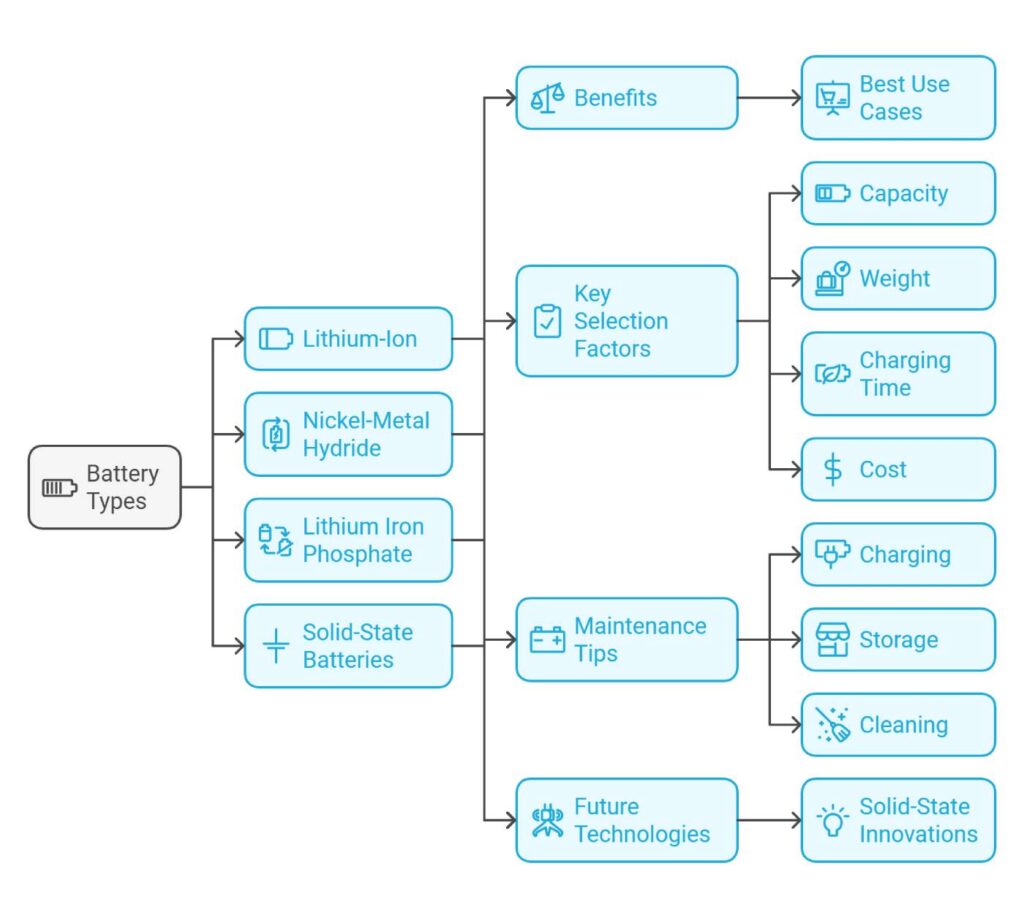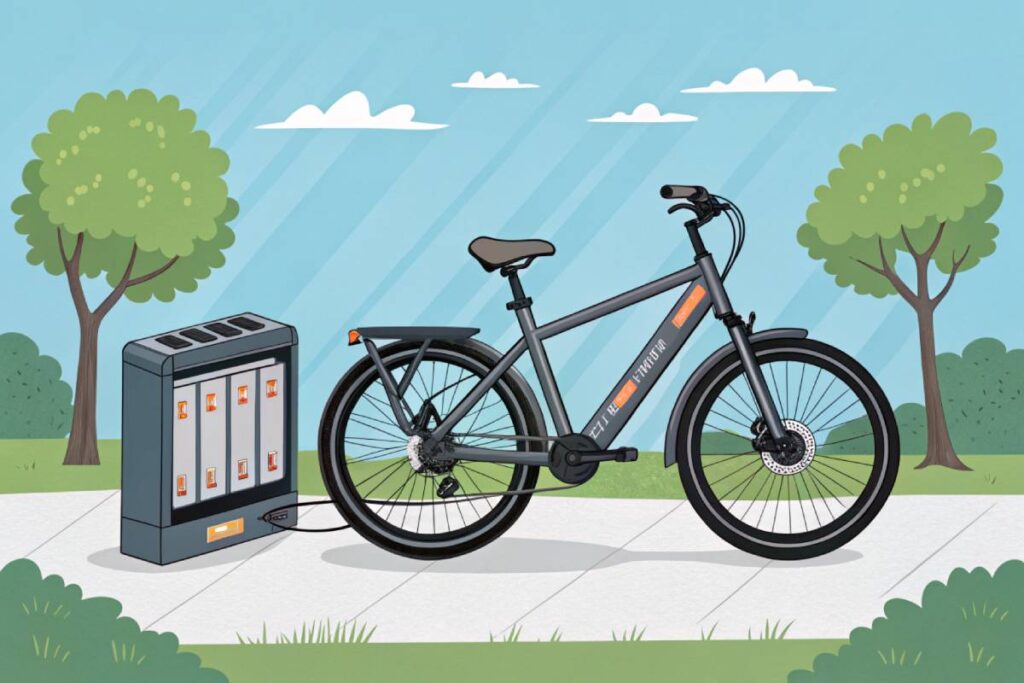Imagine cruising effortlessly through city streets or conquering rugged trails with ease—thanks to the power beneath your pedals. Electric bikes (ebikes) are revolutionizing the way we ride, blending eco-friendliness with unmatched convenience.
At the heart of every ebike lies its battery, the true game-changer that determines your ride’s performance and longevity. Whether you’re a seasoned cyclist or a weekend adventurer, understanding the different ebike battery types can elevate your cycling experience to new heights.
Let’s dive into the world of ebike batteries and discover which one powers your perfect journey.
Understanding Ebike Batteries
Electric bikes are changing the game for getting around, with their green vibe and ease of use gaining fans from crowded city streets to open trails. From young adventure seekers zooming through parks to grandparents enjoying a weekend ride, ebikes are the new wheels for all ages.
At the core of these bikes lies the powerhouse – the battery. This guy’s responsible for making your two-wheeled buddy zip around with oomph and staying in the game for as long as possible. Let’s take a look at the different types of batteries they use and what should be considered when picking one.
Popular Battery Types
Batteries come in different types, each packed with its perks and quirks. Here’s a closer look at some favorites:
1. Lithium-ion Batteries
- The MVP for ebikes! Lithium-ion batteries are loved for their ability to hold a longer charge, offering smooth rides without weighing you down. Plus, they charge pretty fast and forget those dreaded memory effects – once you go lithium, there’s no turning back!
2. Nickel-Metal Hydride (NiMH) Batteries
- A cheaper option in the market. These batteries do well for stuff that’s not too demanding, like small gadgets. They’re old-school reliable and have served roles in cordless tools and electronic devices aplenty.
3. Lithium-iron-phosphate (LiFePO4) Batteries
- Safety first! These batteries are all about keeping things cool and calm, reducing overheating and possible flare-ups. They’re a solid choice if you want peace of mind along with power.
4. Solid-state Batteries
- The new kid on the block, with fresh ideas for cutting-edge performance. By changing up the battery formula with solid stuff inside, these aim to perform better without the usual hiccups of conventional designs.
Factors Influencing Battery Choice
When picking a battery, there are a few things to keep in mind:
1. Energy Density:
- Imagine squeezing more juice out of your power pack. Higher energy density means longer riding on a single charge – ideal for lithium-ion cheerleaders.
2. Cost:
- Budget watchers, take a peek at NiMH for cheaper tags; however, you might be swapping them out more often compared to their lithium-on counterparts.
3. Weight:
- Want a nimble ride? Lighter batteries help keep your ebike agile and easy to handle, and lithium-ion options usually offer that.
4. Lifespan:
- Nobody likes frequent battery swaps. Lithium-ion and LiFePO4 batteries tend to keep showing up for work longer than the NiMH type.
5. Safety:
- Keeping things safe while rolling on two wheels is crucial. LiFePO4 takes the prize for maximum safety features, so you can ride worry-free.
6. Charging Time:
- Nobody’s got time for long waits. Fast charging is what makes lithium-ion part of any commuter’s toolkit, getting you back on the road pronto.
| Battery Type | Energy Density | Average Lifespan | Charging Time | Safety |
|---|---|---|---|---|
| Lithium-ion | High | Long | Short | Moderate |
| NiMH | Moderate | Moderate | Long | Moderate |
| LiFePO4 | Moderate | Long | Moderate | High |
| Solid-state | High (Emerging) | Long (Potential) | Short | High (Potential) |
Need a deeper dive into which battery’s right for you? Check out the best ebike batteries for more details. For tips on keeping your battery in top shape and learning the ropes of charging, find your answers at electric bike battery care and How to charge ebike. The right battery choice can transform every ride, making sure you get every thrill safely and reliably.

Lithium-ion Batteries
Benefits of Lithium-ion
You hear “lithium-ion” these days, and it’s like hearing about sliced bread in the battery world—everyone loves it! These little powerhouses have quite a fame for saving the day with ebike battery options.
Enhanced Energy Density
Why are lithium-ion batteries all the buzz? Well, it’s kind of like packing a week’s worth of snacks in a lunchbox. They cram heaps of energy into a small, lightweight space, letting riders travel farther without the dreaded “low battery” anxiety. So, feel free to plan that extra-long scenic ride without breaking a sweat over the charge.
| Battery Type | Energy Density (Wh/kg) |
|---|---|
| Lithium-ion | 150-200 |
| NiMH | 60-120 |
| Lead-acid | 30-50 |
Thanks to Electric Parts Depot for the stats!
Lightweight Design
Lugging around a heavy battery? Nobody’s got time for that! Lithium-ion types keep things light, turning your ride into a breeze. No more huffing and puffing—just smooth, easy riding all day.
Extended Lifespan
A good buddy sticks around, and so do lithium-ion batteries if you take care of ’em. They can keep going and going cycle after cycle without leaving you high and dry. It’s like hitting the battery jackpot for long-term ebike fun.
| Battery Type | Lifespan (Years) | Charge Cycles |
|---|---|---|
| Lithium-ion | 2-3 | 500-1,000 |
| NiMH | 1-2 | 300-500 |
| Lead-acid | 1-1.5 | 200-300 |
Facts are courtesy of Whizz.
Faster Charging Times
In a rush? Lithium-ion’s got your back with speedy charging, cutting down waiting time between rides. Great news if you’re zipping around the city or hustling on deliveries.
Hungry for more on charging advice? Check out our guide on how to charge an ebike.
Recycling Initiatives
With more folks hopping on the electric bike bandwagon, the need for recycling lithium-ion batteries has shifted into high gear. Proper recycling is key to keeping things eco-friendly and sustainable.
Efforts to Recycle
Several initiatives help with recycling these powerful yet tricky gadgets. They focus on safe disposal and spiffing up battery bits—so they’re not just landfill fillers.
- Manufacturer Take-back Programs: Some bike makers will happily take back old batteries for recycling.
- Dedicated Recycling Centers: These spots are all about handling battery disposal safely.
- Partnerships with Retailers: Retail shops team up with recycling groups to gather used batteries for repurposing.
Joining the battery recycling crew helps tackle electronic waste and save precious resources. For tips to keep your battery in top shape, swing by our electric bike battery care page.
Knowing why lithium-ion batteries are fab and boosting recycling doesn’t just make you a savvy rider—it helps keep eco-vibes strong. Whether you’re zipping through city streets or doing your part for Mother Nature, your choices can make every ride a little better.
NiMH Batteries
Nickel-Metal Hydride (NiMH) batteries have been around the block as old-timers with their feet still firmly planted in today’s gadgets and gizmos. While their younger cousin, the lithium-ion battery, often steals the show, NiMH batteries hold their ground for certain electric bike uses thanks to their budget-friendly nature and versatility.
Cost-effectiveness
Everyone loves a good bargain, right? NiMH batteries come with a wallet-friendly vibe, making them perfect for tasks that don’t need heaps of energy. It’s like the eco-friendly squad’s dream come true, offering a cost-effective alternative without breaking the bank. Check out the expense comparison below:
| Battery Type | Average Cost per Wh |
|---|---|
| NiMH | $0.30 |
| Lithium-ion | $0.50 |
| Solid-State | $0.70 |
Usage Across Devices
NiMH batteries aren’t just sitting around waiting for that next bike ride. They’ve found a home in all sorts of electronic gadgets, from the handy tools we use daily to some of our swankier hybrid vehicles. With decent energy storage and rechargeability, they’re a good fit for:
- Hybrid electric bikes
- Portable electronics like flashlights and cameras
- Remote controls
- Certain hybrid cars
True, they might not stack up on the energy density chart like those fancy lithium-ion or solid-state batteries, but they’re dependable players in situations where long-term cost savings are the name of the game.
Trying to figure out the best battery for your bike trek? Comparing NiMH batteries with other types is essential. If you’re all about squeezing every last drop out of your battery, our electric bike battery care guide is packed with tips to keep them running strong.
Solid-State Batteries
Solid-state batteries are all the rage in the e-bike scene, cooking up a revolution that sidesteps the usual hiccups of old-school battery designs. Instead of the gloopy goop found in others, these bad boys use solid electrolytes. Curious about the ins and outs? Check out more on ebike battery types here.
New Kid on the Block
In the land of batteries, solid-state kings are rolling out with 350-400Wh/kg, potentially cranking out four times the energy. What does that mean for your ride? E-bikes decked out with these wonders weigh half as much but pack double the juice. Plus, imagine charging up to 80% in a mere 10 minutes, and a full tank in 15. Zippy, right?
| Battery | Energy (Wh/kg) | Charge Ups |
|---|---|---|
| Solid-State | 350-400 | 10,000 |
| Lithium-ion | 150-200 | 2,000-3,000 |
Why These Are a Big Deal
Safety’s Secret Weapon: Solid-state batteries put safety front and center with their use of solid electrolytes, cutting out leak risks and dodgy overheating. Those who put safety on a pedestal find these a no-brainer for electric bike battery care.
Energy Buffs: Packing up to quadruple the energy density of lithium-ion, these batteries let you scoot farther on a single charge. Urban warriors and long-haul explorers, rejoice! This upgrade promises a top-tier e-bike adventure. Check out ebike range factors to know more.
Stick-to-Itiveness: With as many as 10,000 recharges in the cards compared to the modest 2,000-3,000 play of lithium-ions, these batteries have staying power. Perfect for those watching their wallet while squeezing every ounce of value from their e-bike.
Speedy Chargers: Some solid-state batteries hit 80% juice in 10 minutes and 100% in 15. That’s music to the ears of delivery folks and daily riders, cutting the wait time to a minimum.
Solid-state tech is setting the stage for high-powered, safer e-bike batteries. For more cool stuff on upcoming tech and maintenance hacks, have a peek at our guides on how to charge ebike and electric bike maintenance.
Battery Comparisons
We all know picking the right battery for your ebike is like choosing the heart of your ride. It’s got to keep up with your lifestyle, especially when it comes to energy and longevity.
Energy Densities
Ever wonder how much oomph a battery’s got? Energy density is your answer—it’s the juice packed within each gram. More energy in a lighter battery? Sign me up! High energy density means your ebike’s gonna last longer and feel lighthearted on the road.
| Battery Type | Energy Density (Wh/Kg) |
|---|---|
| Lithium-ion | 150-250 |
| NiMH | 60-120 |
| Solid-state | 350-400 |
Solid-state batteries are kind of like the new cool kids on the block. Picture this: a whopping 400Wh/Kg! That’s nearly a double upgrade from your average lithium-ion pack. Curious about how this extra energy affects your ride? Check out our breakdown on ebike range factors.
Lifespan Comparisons
Batteries are supposed to stick around as long as possible, right? Think of their lifespan as the number of mornings they can wake up fully recharged. More charge cycles mean less hassle in replacing them down the line.
| Battery Type | Lifespan (Charge Cycles) |
|---|---|
| Lithium-ion | 2000-3000 |
| NiMH | 500-1000 |
| Solid-state | 10,000 |
Solid-state options take the crown here with 10,000 charge cycles, giving lithium-ions and NiMH batteries a real run for their money. It’s the no-brainer choice for anyone wanting their bike to go both the extra mile and many years. For some nifty upkeep advice, pop over to our electric bike maintenance page.
Figuring out these differences in energy and lifespan helps when picking the battery that’s right for you. If you’re interested in diving deeper into different battery types and what they mean for you, head over to our write-up on the best ebike batteries.
Safety Considerations
Picking the right battery for your electric bike isn’t just like choosing toppings for a pizza; it’s all about keeping safe while riding. Here’s a peek at how different batteries—namely lithium-ion, lead-acid, and lithium-iron-phosphate (LiFePO4)—fare in the safety department.
Lithium-ion vs. Lead-acid
Lithium-ion batteries are the popular kids in the ebike circle. They’re loved for their long life, zippy recharge times, and energy efficiency.
Safety:
- They’re often seen as the safer, more dependable option compared to lead-acid batteries. A lead-acid battery’s personality can be sluggish and its lifespan short, especially if you’re planning to conquer hills or whisk it upstairs like Superman.
- Lead-acid batteries have a reputation for being as heavy as a wet blanket, which doesn’t play nice with ebikes that prioritize being lightweight and easy to handle.
Energy Efficiency:
- Lithium-ion batteries play the efficiency game like pros, delivering a steady stream of power just as you’d expect.
Weight:
- Compared to lead-acid, lithium-ion batteries are featherweights, which is a big plus for e-bikers focused on balance and maneuverability.
Let’s break it down with a quick battery smackdown:
| Feature | Lithium-ion | Lead-acid |
|---|---|---|
| Safety | Trustworthy | Not the safest bet |
| Lifespan | Long-lasting | Often short-lived |
| Weight | Light as a feather* | Heavy as rocks |
| Energy Efficiency | Top of the game | Can’t keep up |
| Fast Recharge Speed | Blink, and you’ll miss it | Like watching paint dry |
| Maneuverability Impact | Barely felt | Like walking in mud |
LiFePO4 Safety Benefits
Lithium-iron-phosphate (LiFePO4) batteries show up as the new kids on the block, offering upsides you don’t wanna miss:
1. Safety with a Capital S:
- They’ve got rid of that pesky combustible stuff found in other lithium-ion batteries, meaning they’re much less likely to surprise you with fires.
2. Sticking Around Longer:
- With a longer lifespan, LiFePO4 batteries make for good pals—you won’t be visiting battery stores anytime soon.
3. Stable Under Fire (Not Literally):
- If you’re riding in wild temperatures, these guys keep it cool, reducing overheating risks.
4. More Ride, Less Charge:
- Perfect for those who love to ride without worrying about finding the next charging station.
5. Lightweight Strategy:
- Generally lighter than those lead-acid weights but may have a tad more heft than standard lithium-ion ones, yet still a win for ebikers.
To keep your ebike battery healthy and kicking, swing by our battery care guide and learn how to charge it like a pro.
Choosing safe, efficient battery tech means more rides and less fuss. For more on keeping your ride smooth, check out our page on electric bike maintenance and other ebike goodies.

Future Battery Technologies
Solid-state Innovations
Solid-state batteries are shaking things up in the e-bike world. They’re like the cool new kid on the block that everyone wants to be friends with. Unlike your old-school lithium-ion batteries packed with liquid or gel electrolytes, these solid-state buddies come packed with, yep, you guessed it, solid electrolytes. And they don’t just sit there looking tough; they bring a whole lot of stability and safety to the party.
So what’s so great about these solid-state wonders? Let’s break it down:
- Lives Longer: Think about a battery that keeps going long after others have called it quits. Solid-state batteries can clock in around 10,000 charge cycles before they show any signs of quitting, while your typical lithium-ion counterparts? Only about 2000-3000 cycles.
- Fast as Lightning: How does charging up to 80% in just 10 minutes sound? And totally juiced up in 15? That’s way quicker than waiting hours for a traditional battery to fill up.
- Energy to Spare: These batteries pack 350-400Wh per kilogram. That’s double the juice most lithium-ion packs chug along with. So you’re looking at smaller, lighter, and more powerful batteries.
| Battery Type | Charge Cycles | Charging Time (to 100%) | Energy Density (Wh/Kg) |
|---|---|---|---|
| Lithium-ion | 2000-3000 | About 2-3 hours | 150-200 |
| Solid-State | Up to 10,000 | 15 minutes | 350-400 |
Enhanced Performance Prospects
E-bike battery tech is buzzing with thrilling improvements, mainly thanks to solid-state batteries muscling their way in. You can bet these shifts will change the game for urban travelers, green warriors, and weekend riders all around.
Performance Pump-Ups:
- Boosted Range: With all that energy density, these batteries can help your e-bike cruise longer distances on a single charge. Could make ditching the car for those longer jaunts a real possibility.
- Light as a Feather: Lighten up, literally. Solid-state batteries mean less weight, which translates into easier handling. Delivery folks and anyone who could do with less to lug around will love it.
- Safety First: Overheating and leaks? Not on solid-state’s watch. They keep things cool and safer for everyone involved.
- Charge and Go: Less time twiddling your thumbs waiting for a charge means more time enjoying the ride.
The move toward solid-state is like taking a giant leap forward in e-bike battery land. Expect even more efficient, safer, and greener rides as the tech grows.
Curious how to get the most from your e-bike battery? Dive into our tips on e-bike battery care, or find out how to charge an e-bike and maximize your power usage right here.
Maximizing Battery Usage
Gettin’ the best juice outta your e-bike battery ain’t rocket science, but it’s gotta be done right. From charging like a pro to keeping up with some good ol’ maintenance, you’ll keep your e-bike zippin’ along whether you’re shuffling through city streets, cruising in comfort, power-pedalin’, or just enjoying exploring the world of e-bikes.
Charging Best Practices
Wanna keep that battery in tip-top shape? Here’s how to charge it like a champ:
- Charge When Needed: Don’t be the one who lets it run till it’s gasping for life. Give it some electrons when it hits about 20-25%. That’s how you keep it happy. And full.
- Partial Charging: Don’t fill that sucker all the way; stop around 90%. Keeps it spry and in action for the long haul.
- Storage Charging: Gonna park it for a spell? Leave it half-fed at 50%, and give it a little pick-me-up every few weeks or so.
- Avoid Extreme Temperatures: Keep it chill. Charge it in a cozy spot, not in an oven. Heat kills batteries, and they don’t grow back.
If you need a refresher, check out our lowdown on how to charge ebike.
Longevity and Maintenance Tips
Wanna keep your battery kickin’ longer than your uncle’s favorite vinyl? Dig into these maintenance gems:
- Regular Use: Don’t let it rust! Ride often; it’s good exercise for you and keeps the battery’s heart ticking.
- Keep It Clean: Ain’t nobody got time for dirty contacts. Wipe off the gunk to keep charging smoothly and swiftly.
- Check for Damage: Give it a look-see often. Bad batteries can be, well, bad news—like birthday candles you can’t blow out.
- Proper Storage: Your battery deserves a nice home. Cool, dry, and comfy—leave the extremes for the thrill-seekers. More tips in our storing electric bike guide.
- Avoid Overcharging and Deep Discharging: Overcharging equals overheating. Deep discharging? It’s like leaving the lights on all night—just don’t.
| Maintenance Tips | Description |
|---|---|
| Charge when needed | Recharge at 20-25% and stop at 90% |
| Store partially charged | Charge to 50% for long-term storage |
| Temperature control | Charge and store in nice, comfy spots |
| Regular use | Ride often for top battery health |
| Cleanliness | Keep battery and contacts squeaky clean |
| Inspect for damage | Eye it up for any wear or tear |
| Safe storage | Storaged in cool, dry hideaways |
Keep these handy habits and you’ll keep that e-bike battery buzzing awesomely. For even more battery care and tips on handling your electric stead, take a gander at our journey into electric bike maintenance and ebike troubleshooting.
Conclusion
Choosing the right battery is pivotal to unlocking the full potential of your ebike. From reliable and widely-used lithium-ion batteries to innovative solid-state options, each type brings its own set of advantages tailored to different riding styles and preferences.
Understanding factors like energy density, cost, weight, lifespan, safety, and charging time empowers you to make an informed decision that aligns with your cycling needs and budget.
Additionally, embracing proper battery maintenance practices can significantly extend the life and efficiency of your power source, ensuring countless enjoyable rides ahead.
As the ebike industry continues to evolve, emerging technologies like solid-state batteries promise even greater advancements in performance and safety. Coupled with robust recycling initiatives, the future of ebike batteries not only enhances our riding experience but also supports a more sustainable environment.
Whether you’re navigating bustling city streets or exploring serene trails, the right battery choice can transform every journey, making your ebike a reliable and eco-friendly companion.
Dive deeper into our comprehensive guides and resources to keep your ebike journey smooth, powerful, and endlessly enjoyable.
FAQs
What is the most common type of battery used in ebikes?
Lithium-ion batteries are the most popular due to their high energy density, lightweight design, and long lifespan, making them ideal for a wide range of ebike applications.
How can I extend the lifespan of my ebike battery?
To maximize battery life, charge it regularly without letting it completely drain, avoid extreme temperatures, and follow the manufacturer’s maintenance guidelines.
Are solid-state batteries better than lithium-ion for ebikes?
Yes, solid-state batteries offer higher energy density, faster charging times, longer lifespan, and enhanced safety compared to traditional lithium-ion batteries, though they are still emerging in the market.
What should I consider when choosing an ebike battery?
Key factors include energy density, cost, weight, lifespan, safety features, and charging time to ensure the battery meets your specific riding needs.
Can I recycle my old ebike battery?
Absolutely. Many manufacturers and dedicated recycling centers offer programs to safely recycle old batteries, promoting environmental sustainability.
Final Thoughts
Electric bikes are more than just a trend—they’re a sustainable and efficient mode of transportation reshaping how we navigate our world. Central to their performance is the battery, the unsung hero that powers every adventure.
By understanding the different types of ebike batteries, from the reliable lithium-ion to the groundbreaking solid-state, riders can make informed choices that enhance their cycling experience and align with their personal needs.
Moreover, as battery technology continues to advance, the future holds even more promise for longer rides, faster charging, and greater safety. Embracing proper maintenance and supporting recycling initiatives not only extends the life of your ebike but also contributes to a greener planet.
At MyBikeReview.com, we’re committed to providing you with the knowledge and resources to make the most of your electric biking journey.
Whether you’re a daily commuter or a weekend explorer, the right battery can make all the difference. Here’s to many more miles of smooth, powerful, and eco-friendly rides ahead!
Key Tips Around Ebike Batteries
- Regular Charging: Avoid letting your battery drain completely. Recharge when it reaches 20-25% to maintain optimal health.
- Partial Charging: Stop charging around 90% to extend battery lifespan and prevent overcharging.
- Proper Storage: If storing for extended periods, keep the battery at 50% charge in a cool, dry place.
- Temperature Control: Charge your battery in a temperature-controlled environment to prevent damage from extreme heat or cold.
- Clean Contacts: Keep battery contacts clean and free from debris to ensure efficient charging and performance.
- Avoid Overuse: Balance usage between motor assistance and pedaling to reduce strain on the battery.
- Inspect Regularly: Check for any signs of wear or damage and address issues promptly to avoid safety hazards.
- Follow Manufacturer Guidelines: Always adhere to the specific care instructions provided by your battery’s manufacturer.
Recommended Biking Products and Accessories
- Lithium-Ion Batteries:
- Shimano Steps E8000 Battery Pack – High performance and reliability for long-distance rides.
- NiMH Batteries:
- Duracell Rechargeable NiMH Battery Pack – Budget-friendly option for light ebike use.
- LiFePO4 Batteries:
- Battle Born LiFePO4 Battery – Known for safety and long lifespan.
- Solid-State Batteries:
- Quantum Systems Solid-State Battery – Cutting-edge technology for enhanced performance.
- Battery Chargers:
- Smartraxx Lithium Battery Charger – Fast and efficient charging compatible with multiple battery types.
- Battery Management Systems (BMS):
- Bestech Power BMS – Ensures safe and efficient battery operation.
- Battery Cases and Protectors:
- Evoc Armor Battery Bag – Protects your battery from the elements and impacts.
- Solar Chargers:
- Goal Zero Nomad 7 Plus – Eco-friendly option for charging on the go.
- Battery Monitors:
- Cycle Analyst v3 – Real-time monitoring of battery performance and usage.
- Replacement Parts:
- EBIKEPARTS.com Replacement Battery Cells – High-quality cells for DIY battery maintenance and upgrades.
Enhance your ebike experience by choosing the right battery and accessories tailored to your riding style and needs. Explore our comprehensive reviews and recommendations to power up your journey with confidence!




